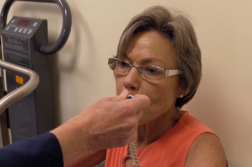SAN JOSE, Calif. (Ivanhoe Newswire) — Two studies out of the University of Washington say seeing a doctor may not be the best first option for low back pain. Both studies show that decreased activity, opioids, and surgery don’t work for most patients. Here’s what these experts suggest instead.
Bianca Frogner, PhD, a Director at Center for Health Workforce Studies and Associate Professor in the Department of Family Medicine at University of Washington was moving boxes into this new house, when she said, “My legs just kind of buckled out from under me, and I just felt this excruciating pain going from my back down to my legs.”
Her team had analyzed 150,000 insurance claims and found that patients who saw a physical therapist first for low back pain lowered their probability of getting opioids prescribed by 89 percent, advanced imaging by 28 percent, and an emergency room visit by 15 percent.
Professor Frogner told Ivanhoe, “A physical therapist is telling you to move your body in certain ways, and it seems almost too easy that the only thing you need to do is stretch.”
Physical therapy worked for her, without drugs or a doctor.
Pain management specialist Judith A. Turner, PhD, a Professor at University of Washington School of Medicine and President at International Association of the Study of Pain reviewed many studies and found that surgery is not indicated for most low back pain problems.
“All too often, people get the advice to stop everything that they’re doing, rest, take some opioid medication. And, we know now that’s the wrong treatment,” explained Professor Turner.
Instead, she found most people responded better to exercise and cognitive behavior therapy like relaxation and pain-coping skills that train the brain to respond differently. Professor Frogner said insurance coverage often dictates what treatment people receive for pain.
She also stated, “I think there just needs to be more studies to understand whether we’re really incentivizing patients to see the best provider for the kind of care they need.”
Professor Frogner said people in all 50 states have the right to see a physical therapist without a doctor referral but their insurance policy may require doctor referrals. Many patients don’t take advantage of this because their insurance copays may be higher for a physical therapist than for a doctor.
Contributors to this news report include: Jennifer Winter, Field Producer, Roque Correa, Editor and Rusty Reed, Photographer.
Free weekly e-mail on Medical Breakthroughs from Ivanhoe. To sign up: http://www.ivanhoe.com/ftk
RETHINKING TREATMENT FOR LOW BACK PAIN
REPORT #2568
BACKGROUND: About 80 percent of adults experience low back pain at some point in their lifetime. It is the most common cause of job-related disability and a leading contributor to missed work days. Men and women are equally affected by low back pain, which can range in intensity from a dull, constant ache to a sudden, sharp sensation that leaves the person incapacitated. Most low back pain is acute, or short term, and lasts a few days to a few weeks. It tends to resolve on its own with self-care and there is no residual loss of function. Chronic back pain is defined as pain that persists for 12 weeks or longer, even after an initial injury or underlying cause of acute low back pain has been treated. About 20 percent of people affected by acute low back pain develop chronic low back pain with persistent symptoms at one year. In some cases, treatment successfully relieves chronic low back pain, but in other cases pain persists despite medical and surgical treatment.
(Source: https://www.ninds.nih.gov/Disorders/Patient-Caregiver-Education/Fact-Sheets/Low-Back-Pain-Fact-Sheet)
CURRENT TREATMENTS: The basic treatment for relieving acute back pain from strain or minor injury is a limited period of rest for 24 to 72 hours. An ice pack can be helpful, as can aspirin or another nonsteroidal anti-inflammatory drug to reduce pain and inflammation. Physical therapy may be prescribed for back pain like massage, ultrasound, whirlpool baths, controlled application of heat, and individually tailored exercise programs to help you regain full use of the back. Strengthening both the abdominal and back muscles helps stabilize the spine. If back pain keeps you from normal daily activities, your doctor can help by recommending or prescribing pain medications. Over-the-counter painkillers such as Tylenol, aspirin, or NSAIDs, such as ketoprofen, ibuprofen (Advil, Motrin), and naproxen (Aleve) can be helpful. For severe pain, your doctor may prescribe prescription strength anti-inflammatories/pain medicines or may prefer to prescribe a short-term combination of opioid (narcotic) and acetaminophen medications such as Vicodin or Percocet. Opioids can be addictive and their use on a long-term basis should be avoided unless a definite cause of back pain related to an injury or a disease can be established.
(Source: https://www.webmd.com/back-pain/back-pain-treatment#1)
REVOLUTIONARY BREAKTHROUGH: Most back pain is short-term, but about 20 percent of people affected by acute low back pain go on to develop chronic low back pain lasting a year or more. “The body reacts with muscle constriction, which decreases the distance between vertebrae, and a vicious cycle is created,” said Alessandro Napoli M.D., Ph.D., an interventional radiologist at Sapienza University of Rome. The single-center prospective study included 80 patients experiencing at least three months of low back pain due to a herniated disk that had not responded to conservative treatments including exercise and medication. The patients underwent a minimally invasive interventional radiology procedure in which, with the help of CT imaging, a needle is guided to the location of the bulging disc and nerve root. A probe is then inserted through the needle tip and delivers pulsed radiofrequency energy to the area over a 10-minute period. Even without touching the disc, the pulsation serves to resolve the herniation. Of the 80 patients treated, 81 percent were pain-free one year after a single 10-minute treatment session, six patients required a second pulsed radiofrequency session, and 90 percent of the patients were able to avoid surgical treatment. “Following this treatment, inflammation and pain go away. With relaxation of the muscles, the distance between the vertebrae returns,” Dr. Napoli explained.
(Source: https://www.sciencedaily.com/releases/2017/11/171129090431.htm)
* For More Information, Contact:
Bobbi Nodell, Media Relations Manager
206-54-7129



